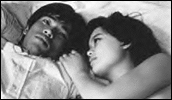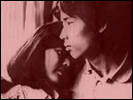Nanami, First Love
- Year
- 1968
- Original title
- Hatsukoi Jigokuhen
- Japanese title
- 初恋・地獄篇
- Alternative title
- Inferno of First Love
- Director
- Cast
- Running time
- 104 minutes
- Published
- 31 October 2001


by Jasper Sharp
A young couple check into a hotel room to make love for the very first time. The boy, Shun (Takahashi) is timid and gauche, hiding his face and retreating to the bathroom for a glass of water as the young girl Nanami (Ishii) undresses before him. She is less shy - she earns her living as a nude model. Finding himself embarrassed by his awkward attempts at foreplay, they agree that they need to get to know each other better before committing themselves to the act of love. After arranging to meet again at a later date, the two of them begin tentatively discussing their pasts.
Though at times vaguely reminiscent to Korean director Sang-Soo Hong's romantic comedy of manners, Virgin Stripped Bare By Her Bachelors / Oh! Soo Jung (2000), this best known work of crucial player in the Japanese New Wave movement of the 1960s, Susumu Hani, is much more than a story of young love. It is a vivid account of a young man's confusing first steps into the dark and mysterious domain of adult sexuality. It is also, as its descriptive alternate title The Inferno of First Love suggests, a vivid articulation of the overwhelming and cloying sensations that accompany this emergence from adolescence.
Originally a stills photographer, at the beginning of the 1950s Hani moved to Iwanami Studios, a company specialising in documentaries, where he made his name with a series of well regarded shorts. The best known of these, Children Who Draw Pictures (E o Kaku Kodomotachi, 1956) won several international prizes and highlighted Hani's concern with young subjects, also seen in such films as Children in the Classroom (Kyoshitsu no Kodomotachi, 1954) and his first feature, Bad Boys (Furyo Shonen, 1961). For this latter film, about juvenile delinquents, he staged scenes using child amateur actors in a real-life reform school, improvising the dialogue and incorporating his subjects' firsthand experiences into the script. This melding of fictional narrative with documentary technique to create a new kind of cinematic realism was used again by Hani in later films such as He and She (Kanojo to Kare, 1963), focusing on a loveless marriage in an austere tenement block to portray the dehumanising effects of modern living, and The Song of Bwana Toshi (Bwana Toshi no Uta, 1965), a docu-drama set in Kenya that anticipated the director's later wildlife documentaries for Japanese television.
Hani's pioneering approach to feature fiction was also adopted by other Japanese New Wave directors such as Oshima and Imamura, who made use of such practices as hand-held shooting, hidden cameras, non-synched dialogue, on-location shooting, and use of a non-professional cast as a rejection of the styles and ideals being promoted by contemporary Japanese cinema. In this way, the New Wave movement was not merely about stylistic innovation. It also took on a political dimension. For the first time, films could be produced independently and cheaply giving the director a degree of autonomy from the major studios whose films, with their firm adherence to traditional values and tried and tested theatrical techniques, were criticised as playing safe. Instead, the major players in the movement began to use the medium as a means to critique and comment upon society and culture, then in a violent state of flux due to the country's rapid industrialisation and increasing Westernisation.
Shot in grainy 16mm monochrome, Nanami, First Love portrays a bleak and inhospitable world in which any chance of emotional connection is stifled by traditions and patterns of behaviour that are passed down from generation to generation. Shun's mother abandoned him in a reform school at an early age after marrying a boxer when his father died. He was taken in by a childless couple, though the adoption was never official. He now works as an apprentice metal worker for his foster father and spends his free days feeding the pigeons with his unlikely best friend, a five-year-old girl called Momi. Following a public lynching when his innocent intentions with the youngster are misinterpreted, he is sent off to a psychiatrist who reveals under hypnosis that Shun himself has been continuously molested by his foster father during his own upbringing.
Though Shun initially seems unperturbed by Nanami's profession as a nude model posing for frustrated salarymen in Tokyo's Shinjuku district, a job which she took because it paid better than her previous post working in a factory ("We're good girls", she tells him), the seedy milieu in which she works remains threateningly alien to him as he skulks around it in order to get closer to her. Hani pulls no punches in its portrayal, which probably accounts for a good proportion of the missing footage from the original 82-minute US release print. A lengthy hypnotic sequence featuring staged S&M scenes for the men that pay to photograph the girls (a similar set-piece is featured in Ken Loach's seminal piece of British social-realism, Poor Cow, 1967) is indeed shot incredibly erotically. However it does fit in with the oppressive vision developed throughout the rest of the film.
The recurrent incest motif, which in today's climate in the West may seem dangerously close to the bone, probably has more relevance within the context of Japanese mother-son relationships, yet also echoes the point that is being made throughout the rest of the film. Shun's impotence is a result of the suffocating societal and family pressures that cramp the emotional development of its children, and in which make it is virtually impossible for the young couple to find enough space for themselves away from the corrupting influence of their elders.
Flashbacks to Shun's childhood before being abandoned by his mother, shot in misted, over-exposed, oval frames, occur during his moments of physical proximity to Nanami. Similarly a scene in which he invokes the same image as he masturbates suggests that union with the archetypal female fantasy figure of Nanami is a return to a pre-Oedipal bliss, an uncomplicated innocence. These Freudian overtones are underscored by the threatening presence of Nanami's main client and benefactor, Mr Ankoguchi, who acts as an obstacle between Shun's emotional monopoly of Nanami's affections and ridicules his proclamations of love as young idealism. "I get excited when I see the scars on her back", he announces proprietorially. "They're mine. She made them for me". Money can't buy love, perhaps, but it can pervert its true course.
"When you peel a cabbage, the core comes out. What happens when you peel an onion?" is the riddle that the young girl Momi puts to Shun at the beginning of the film to suggest a metaphor with the accumulated protective layers that need to be stripped away in order for Shun to bear himself emotionally to Nanami. It is Nanami who provides the cryptic answer at the end of the film - "Tears".
Co-scripted with the poet/playwright Shuji Terayama, another giant of the New Wave (whose reputation outside of Japan unfortunately lies predominantly with the glossy porn film Fruits of Passion), Hani lays down each scene with all the intellectual rigour of a cinematic essay. Raw yet compelling, this lyrical and occasionally surreal account of a young man's psycho-sexual odyssey as he struggles to come to terms with his troubled emotional background is a remarkable accomplishment, both as a sensitive psychological study and a nightmarish portrait of restricted sexuality.